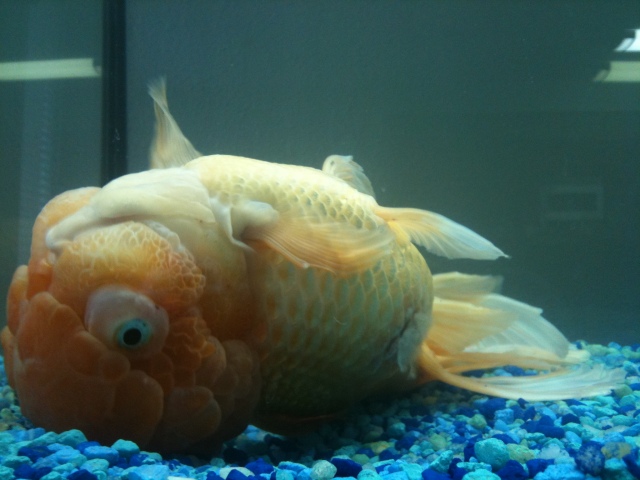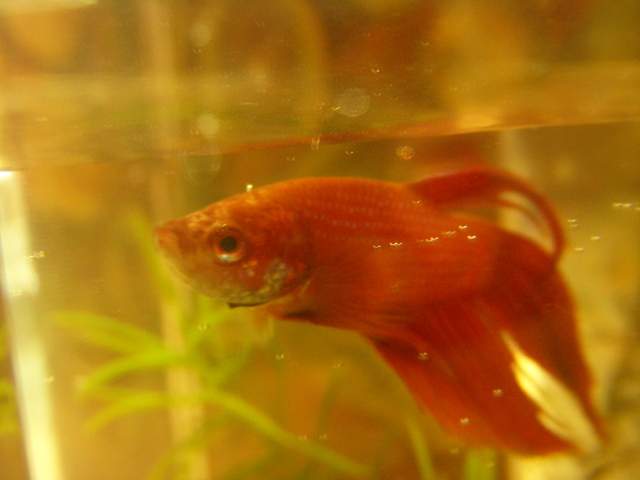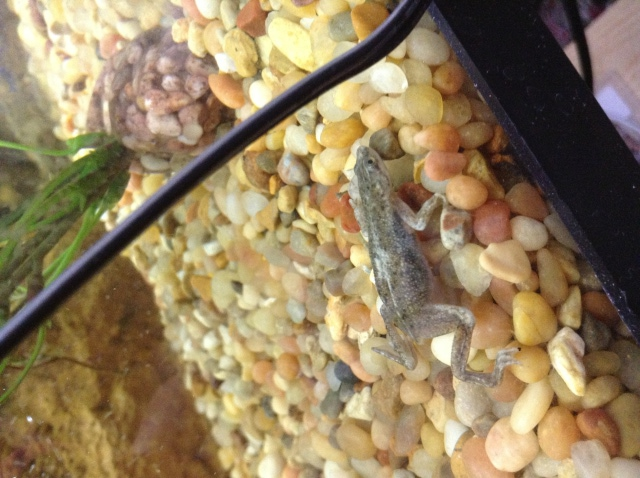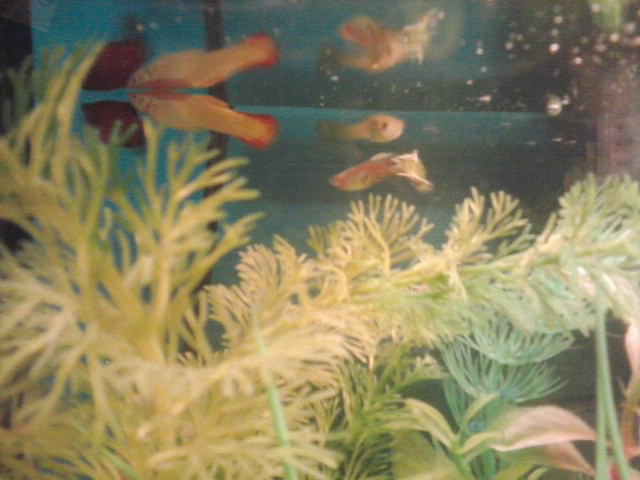QuestionWe'll call this my first aquarium, because my last one was when I was five...I'm 26 now.
I bought a brand new 10 gallon aquarium on friday, set it up friday night, and let it sit until monday afternoon. I purchased one silver male molly and one calico female molly.
She will eat, he will not (spits it out but keeps going after the broken pieces and spits those out too).
She has developed rather red gills today.
He was swimming frantically up and down one side of the tank and is still doing so now, after a 25% water change (and adding Tetra Aquasafe water conditioner) but less frantically.
A friend of mine used to work in the aquarium dept. at PetCo and said 99.9% of the time your first fish will die because of the "Nitrite Cycle" where your fish will die but that's good because the dead fish will condition the tank's nitrite levels for the "real" fish you want to add later. I don't buy it...so I would appreciate REAL advice.
I'm rather attached to these fish already and would like to avoid killing them.
Before and after the water change today the pH was 7.0 exactly. The NH3/NH4 level is somewhere between 0 and 0.25 p.p.m.
And that's where I stand for now. I'm planning on changing the water daily and adding more tetra safe water conditioner with each change....and I'm not going to feed for a day or so at all.
Other stupid questions of mine: when I add the water conditioner it says to add 8 drops per gallon, but is that per added gallon or for the whole tank?
And if the pH wavers and I want to add the pH up or down liquid, is that safe to do with the fish in the tank?
Thanks so much for your time. I appreciate any help you can offer.
Gina
AnswerHi Gina;
They are stressed from "New tank Syndrome". It's an excellent idea to stop feeding them for a couple of days. Even a week will not hurt them. Fish can go for 2 or 3 weeks with no food at all. It keeps the waste toxins down to cut back when there are problems. Their bodies are stressed and will not be able to digest very well anyway, or they spit it out like one of yours is doing. Keep making water changes every day. Replace about 25% or so. It will lower the concentration of toxins. When you do start feeding them again, make it vegetables. Don't feed regular food for another week, just vegies. Vegies do not decay like regular flakes or pellets do. This means they won't pollute the water so much. Mollies require greens in their diets to thrive on a long term basis anyway. I feed my fish cooked green beans, cooked green peas (peeled), raw romaine lettuce, raw squash chunks, raw cucumber chunks. Just rinse and drop them in. Another food available in fish or pet stores (either dry or frozen) is spirulina algae. It has such a wonderful assortment of nutrients. Just a great supplement food for all kinds of fish.
None of your questions are stupid at all. You can't learn new things if you don't ask! Better to find out first than make costly mistakes that could be avoided in the first place.
Whenever using water conditioner add the right amount for the whole tank. That way, your fish get the full concentration of stress relief from it. If you add only what treats the new water, it will be diluted too much. It's more expensive that way, but much safer. Larger bottles of water conditioner are more economical so you may want to get one of those while you are doing so many water changes.
Don't alter the pH with chemicals. It is very stressful for the fish to have those quick fluctuations. Chemical additives may change the pH for a short time and then boomerang back to where they were originally, so you add more, and on and on for a nightmare rollercoaster ride of pH fluctuations. Fish are adjustable as long as it is slowly and gradually in one direction. That's one of the reasons partial water changes are so important. Large changes shock the fish in many ways, including pH.
Okay....now for the nitrogen cycle/dead fish issue; Your fish DO NOT have to die for the nitrogen cycle to be successful. This is a myth perpetuated for profit by many fish store retailers. You really can't put the blame on the workers though. They are only practicing what they are taught by their employers. Dead fish cause a spike in ammonia and a huge spike in nitrites afterward. It will eventually drop but it is deadly for the other fish. Beneficial bacteria that are part of the nitrogen cycle do thrive on decaying dead bodies, but so do harmful bacteria and fungi. It's just very unhealthy and can set your next batch of fish up for a blast of killer diseases as soon as they hit the water. {{{shuddering}}} Yikes!
Here is my article on new tanks to help you through the whole crazy process;
**********
New Tank Syndrome or Break-in Period
So you have a new tank and you filled it up, put the filter together, mounted the heater into place and turned on the lights. You have all the plants and decorations where you want them....
You are ready for fish.
But, your filter is not ready for a full tank of fish yet.
The filter is running and moving the water and cleaning out crud, right? Of course!
But a very important part of your filter is the part you can't see. An aquarium filter removes the larger visible stuff, but it also must remove the dissolved fish waste that turns into ammonia in the water. To do this, special bacteria must grow in the filter system and on the particles of gravel in the bottom of your tank. This process occurs even on a limited scale in little fish bowls that have no filter in them.
This is "New-Tank Syndrome" or the "Break-in Period". The entire process takes 6 to 8 weeks to complete because these "nitrifying" bacteria grow quite slowly.
Start off with only one or two hardy fish (no more than 2 total inches of fish) for every ten gallons of water and don't add more until the 6 to 8 weeks has gone by. Hard to be patient, but it is worth it to keep your fish alive and healthy. As a matter of fact, the bacteria cannot develop without fish in the tank. You can let that tank sit forever without fish in it, but as soon as the first fish goes in the process begins. Avoid changing the filter pads during break-in. This removes the bacterial colonies that are essential to a balanced aquarium. You can rinse the filter pad out in a container of aquarium water. This will preserve most of the bacteria colonies while still allowing your filter to flow freely. Even using bacteria additives and water conditioners when you first set up the tank will not make a tank begin the cycle by itself. If there are no fish to provide food (fish waste) for the bacteria, the beneficial bacteria cultures will die and you will have to start the colonies all over again once fish are added to the tank. Once the tank has completed the initial cycle, you can change the filter pads every 4 weeks or so. But for now, just rinse them.
Feed your new fish VERY lightly. Any excess food will cause additional waste your system cannot afford to have right now. If you see food floating around or lying on the plants and gravel after five minutes, too much food is going into the tank. Cut back a little each time you feed until it is ALL gone 5 minutes after you feed them. Feed them once a day.
During this "break-in period" your tank will become cloudy and milky looking. You may have to tolerate this for the entire break-in period but it is only temporary. Changing 25% of the water three times a week until the break-in period is over helps a great deal. Changing water reduces the ammonia and nitrites that rise while the bacteria continues to multiply. If ammonia and/or nitrites become too high, your fish will become stressed and possibly die. Use a good water conditioner when you replace the water and make sure it is the right temperature to avoid shocking your fish.
When the break-in is over after 6 to 8 weeks and there are no nitrites or ammonia present in the water you can slowly add more fish. Add one or two every week until you reach the desired population. This allows the bacteria to adjust to the new population every time before adding more. Monitor the nitrites and ammonia to be sure they don't come up. If they do, make a 25% water change and check them again. Don't add the next fish until the levels are down again.
The safe maximum population for any size tank is one inch of adult fish for every gallon of water in the tank. Do some research to be sure of the fish you are interested in. Even though they are small when you buy them, you have to base your population calculations on full-sized adult fish. Many hobbyists have up to two inches per gallon but this can be risky. If a water quality issue arises or a disease occurs it will spread fast and furious in an over-populated tank. In any case, 25% water changes every week to two weeks are absolutely essential for the health of your fish.
Following these guidelines will help you get your new tank on the right track.
**********
At Your Service;
Chris Robbins
Come on over and join us on the freshwater fish forum at About.com to get even more information too;
http://freshaquarium.about.com/od/questionsanswers/a/naavigateforum.htm

 Swim bladder disorder in Lionhead Oranda
Question
Fuzzy spot
Hello! I have been doing res
Swim bladder disorder in Lionhead Oranda
Question
Fuzzy spot
Hello! I have been doing res
 A Catfish I purchased.
Question
The Catfish
Hi, I purchased a catfish yesterda
A Catfish I purchased.
Question
The Catfish
Hi, I purchased a catfish yesterda
 Swim Bladder Disorder???
QuestionJack
QUESTION: My betta fish is bloated.
Swim Bladder Disorder???
QuestionJack
QUESTION: My betta fish is bloated.
 African dwarf frog
Question
Side/top Front
My African dwarf
African dwarf frog
Question
Side/top Front
My African dwarf
 Not sure what to do
QuestionQUESTION: Hi, I have 2 platies a male and a fem
Not sure what to do
QuestionQUESTION: Hi, I have 2 platies a male and a fem